#open pst file without outlook
Explore tagged Tumblr posts
Text
If you don't have access to Outlook, you can still open a PST file. In this article we cover best possible solution to open PST files without outlook.
0 notes
Text
How the MBOX to PST Conversion Tool Improves Workflow
In the modern digital workspace, the ability to efficiently manage and migrate email data is essential. With professionals often needing to switch between different email clients, converting file formats becomes part of daily operations. MBOX and PST are two of the most common email storage formats, but they are typically associated with different email platforms. MBOX is often used by open-source clients, while PST is native to Microsoft Outlook. The MBOX to PST conversion tool bridges the gap, enhancing productivity, ensuring data consistency, and saving valuable time.
Streamlined Migration Between Email Clients
One of the primary benefits of using an MBOX to PST conversion tool is seamless migration between email clients. Many users transition from MBOX-supported applications to Outlook for better integration with office tools or corporate environments. Manually migrating data is often complicated, risky, and time-consuming. However, a specialized conversion tool automates this process, eliminating technical barriers. This not only ensures that all messages, attachments, and metadata are accurately transferred but also reduces downtime, allowing professionals to resume work immediately after migration.
Preservation of Data Integrity
Maintaining the integrity of email data during migration is critical. Without the right tools, there is a risk of data corruption, missing attachments, or loss of formatting. The MBOX to PST conversion tool is designed to safeguard the structure and content of every email. Folder hierarchies, embedded files, and date-time stamps are preserved throughout the process. This ensures that no important information is lost, which is vital for professionals handling sensitive communications or legal documentation. The result is a complete and reliable archive that mirrors the original source.
Improved Accessibility and Organization
Switching to PST format provides users with advanced organizational capabilities. Microsoft Outlook, the default application for PST files, offers robust features like search filters, calendar integration, tagging, and categorization. When MBOX files are converted into PST, users can take full advantage of these features. This makes it easier to locate specific messages, manage appointments, and streamline daily communication tasks. With a more intuitive interface and better data organization, teams can work more efficiently and avoid the frustration of sifting through cluttered inboxes.
Enhanced Security and Compatibility
The conversion from MBOX to PST also enhances email security and compatibility within enterprise environments. PST files integrate well with Microsoft 365 and Exchange servers, offering built-in encryption, access control, and cloud backup features. This allows IT departments to enforce compliance policies, implement security protocols, and provide reliable access to archived emails. The conversion tool helps ensure that organizations can securely transition their communication data while maintaining compatibility with enterprise-grade infrastructure.
Saves Time and Reduces Errors
Manually exporting and importing email messages can be error-prone and labor-intensive. A dedicated MBOX to PST conversion tool eliminates these issues by automating complex steps. Users do not need advanced technical knowledge to carry out the migration. Most tools come with user-friendly interfaces and batch conversion features that can handle multiple files at once. This drastically reduces the time spent on administrative tasks, allowing IT professionals and end-users alike to focus on more strategic initiatives.
The MBOX to PST conversion tool plays a pivotal role in optimizing workflow efficiency across various sectors. By offering accurate data transfer, improved email management, and better integration with Outlook, this tool simplifies what would otherwise be a challenging process. Whether for personal use or enterprise-level migrations, the tool ensures that users can adapt to evolving email environments with confidence and ease.
0 notes
Text
Best PST Converter Tool
Want to find the best way to export your Outlook emails safely and without delay? Stop your search now! The BLR PST Converter Tool is created for users in search of a simple but powerful way to convert PST files into MBOX, EML, MSG, and other formats.
Regardless of moving to Thunderbird, Apple Mail, or saving your data for another application, this tool has got you covered and you don’t have to have Outlook set up.
✨ Why PST Converter is the Best: 1. Transfers PST to MBOX, EML, MSG, and different types of format files. 2. Supports opening PST files that are healthy and/or damaged. 3. It organizes data by the way folders are designed, the attachments within, and the metadata they have. 4. No Outlook is required. 5. It's fast, easy to use, and it can convert large numbers of files all at once. 6. Works with all versions of Outlook and Windows.
You can use this tool to move your emails easily, whichever role you have.
Be sure to pick the best PST converter that gives you reliable, accurate, and efficient performance.
0 notes
Text
Portable Outlook Mac Backups with Mail Backup X: Built to Move
Data that lives in one machine, tied to one setup, often becomes fragile. You may not notice this until something shifts, such as acquiring a new device, changing your workspace, traveling, or needing a repair. Outlook for Mac does its job well inside its own environment, but its data doesn’t travel easily. Mail Backup X shifts the balance by creating portable Outlook Mac backups independent of the client or the system.

You can take your archives with you, store them on multiple platforms, and open them independently of Outlook. This creates a working model where your information remains accessible wherever you are.
Setting Up an Outlook Mac Backup That Moves with You
So, first, let’s see how exactly you can do that with the help of “Mail Backup X.”
Begin by opening Mail Backup X and clicking on “My Backup Profiles.” Select “Add New Backup” to begin.
Choose Outlook Mac and then the tool will locate and link to the local database without needing a manual path.
Pick the folders you want to back up.
Give the backup profile a name that reflects its purpose or contents.
Select a storage location. This might be your Mac’s internal drive, an external USB drive, or a connected cloud account. All options create the same .mbs format.
Since portability is the goal, use cloud or external drives as your primary or mirror location. You can add one or more mirrors by clicking the “Add Mirror” button and selecting additional destinations.
Set the schedule. Automatic backups can detect new emails and act as needed. Recurring backups can run at fixed times, every hour, daily, weekly, based on your preference.
If you plug in a USB drive and register it, the tool can automatically copy your Outlook Mac backups to that drive each time it connects.
Click save. The first backup starts immediately. You can continue using Outlook Mac while it runs in the background.
Accessing Your Portable Outlook Mac backups
Once the backup of your Outlook Mac data exists, you can move it anywhere. If you open the software on another Mac or a Windows PC with Mail Backup X installed, you can import the archive using the “Open Archive” button. This creates a new profile in the viewer, where your emails appear exactly as they were backed up, folders intact, attachments preserved, timestamps in place.
You can search through the archive as though it were still part of your live email. The search bar handles both basic queries and complex expressions. This makes it easy to locate a specific piece of information, even inside a large, multi-year archive.
Exporting to Other Formats Without Losing Portability
Let’s say you’re no longer using Outlook or need to switch to a different client. The export feature allows you to convert your Outlook Mac backed up data into formats compatible with the most popular email platforms. You can export an entire folder to PST for Microsoft Outlook or choose EML files for clients like Thunderbird or Apple Mail.
If you want to create a fixed record for documentation, legal, or archival purposes, exporting to PDF offers a practical option.
Each export happens within the viewer itself. Select the folders or messages you want, choose the format, and designate an output location. The software handles the conversion, keeps the structure intact, and reports progress in real time.
How Portable Are Mail Backup X Archives?
Q: What format does the tool use for Outlook Mac backups?
On macOS, each backup profile creates a compressed archive saved as an .mbs package. This archive contains your backed-up Outlook Mac data and can include all folder structures, metadata, and attachments. Unlike standard exports from Outlook, this format is recognized by the tool on any supported machine. That means you can copy it to another system, open it using the app there, and continue working with it just as before.
Q: How can you access the contents of an archive on a new computer?
You launch Mail Backup X on the new system, click “Open Archive,” and select the .mbs file. The app then reindexes the archive, rebuilding the folder view and search-index, so everything appears as it did on the original machine. There is no need to restore anything to Outlook or import it into another mail client. The archive opens as a viewable and searchable profile within the app. Note, seeing the contents of backed up package can also be done through the free version of the tool.
Q: What makes this system more flexible than native Outlook export options?
Outlook’s own export tools produce files like .olm, which are not readable outside the client itself. Mail Backup X archives are readable without Outlook, searchable through the built-in viewer, and transferable between Mac and Windows. If you use different devices at home and at work, or if your machine changes, you won’t lose access to your mail.
Q: Can the tool export Outlook Mac backed up data to standard formats for use elsewhere?
Yes. You can export individual messages or entire folders or the entire profiles into formats like PST, EML, MBOX, and PDF. This means you can migrate your email data into a different client or share selected parts without sending the whole backup. The export function doesn’t require you to unzip or decode the archive manually. Everything happens from within the interface, with folder selection, target format, and destination handled in a few steps.
The Value of Data That Travels Well
There’s freedom in knowing your data is not locked to one interface, one operating system, or one machine. For people who work across platforms, this means fewer technical blocks and smoother handoffs. If you’re handing over a project to someone else, switching devices, or simply archiving years of communication, you want that archive to open and function wherever needed.
Mail Backup X does not build walled gardens. It gives you a way to create Outlook Mac backups that are light to carry and easy to read. From compressed .mbs files to cloud mirrors, from USB snapshots to export tools, everything is shaped with mobility in mind.
A free trial version is available for you to explore these features and see how portable your Outlook Mac email backups can become. The process starts simply but opens into a much larger system of access and control. Once you see your archive appear, complete, structured, and untied from your machine, you begin to understand what portability really looks like.
You don’t start over each time the device changes, or the setup evolves. With Mail Backup X, the Outlook Mac backup remains intact, readable, and ready, wherever your work moves next. What stays with you, in the end, is access without interruption.
0 notes
Text
Download OST File to PDF by Free Converter
Saves OST to PDF format without any restrictions and challenging procedures by the free WebbyAcad OST converter tool. With this software user make the bulk batch conversion of their Outlook OST file. Those orphan OST files are also directly exportable with this tool which is totally separated from Microsoft Outlook. This means users don't need to first convert OST to PST and then convert the OST Email files into Adobe PDF.

Steps to use WebbyAcad OST Converter Tool :-
Obtain software from their product page and then open it on the desktop.
Open the OST File by " Add file " and preview the file email data and attachments.
Select the file format as PDF by dropdown.
Choose file saving location for PDF files otherwise it saves on Desktop.
As the Last press the export button.
Key features of the OST converter Software:-
Bulk File conversion.
Maintain the File Authenticity.
Repair Corrupted OST file.
Compatible with All kinds of Windows OS.
Free updates and 24/7 service support.
Free Demo Trial.
#outlook#outlook ost to pdf#ost to adobe pdf#conversion of ost to pdf format#technology#computing#software
0 notes
Text
How Can I Export PST File From MBOX?
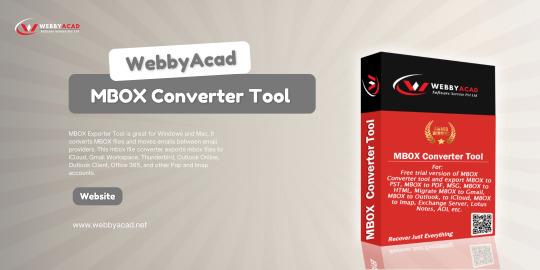
When it comes to migrating emails between different platforms or email clients, one of the most common requirements is converting MBOX files to PST format. MBOX is widely used by email clients such as Thunderbird, Apple Mail, and Gmail for storing email data, while PST is the preferred format for Microsoft Outlook. If you’re transitioning to Outlook from another email platform, exporting your data from MBOX to PST is essential.
we’ll explain the process of exporting PST files from MBOX files, and guide how WebbyAcad MBOX to PST Converter Tool makes the task simple and efficient.
Why Convert MBOX to PST?
Before we start the process, it’s important to understand why converting MBOX to PST is necessary:
Compatibility: MBOX is not natively supported by Microsoft Outlook, which relies on PST for managing and storing emails. If you’re switching to Outlook, converting your MBOX files ensures that your data is fully accessible.
Migration Between Platforms: If you're moving from email clients like Thunderbird, Apple Mail, or Eudora to Outlook, converting your MBOX files to PST will make the transition smooth.
Data Security and Management: PST files are designed for seamless integration with Outlook’s features, ensuring better data management, enhanced security, and greater accessibility across multiple Outlook-supported platforms.
What is process of Exporting PST from MBOX?
There are two primary ways to export PST files from MBOX: the manual method, which involves multiple steps and different email clients, and the professional method using WebbyAcad’s MBOX to PST Converter tool. Let’s explore both methods.
Manual Method for MBOX to PST Conversion
The manual method requires the use of both Mozilla Thunderbird (which supports MBOX files) and Microsoft Outlook (which supports PST files). Below are the key steps involved in manually converting MBOX to PST.
Step 1: Install Mozilla Thunderbird
Download and install Mozilla Thunderbird on your computer. Thunderbird is a free, open-source email client that supports MBOX files.
Step 2: Import MBOX File into Thunderbird
Import your MBOX file into Thunderbird. You can do this using the ImportExportTools NG add-on in Thunderbird:
Go to Tools > Add-ons > Search for "ImportExportTools NG" and install it.
Restart Thunderbird and then go to Tools > ImportExportTools > Import MBOX file.
Locate your MBOX file and import it into Thunderbird.
Step 3: Transfer Emails to Outlook
Open both Thunderbird and Microsoft Outlook.
Drag and drop emails from Thunderbird to Outlook. Unfortunately, this process can be tedious, especially if you have a large volume of emails or multiple MBOX files to convert.
Step 4: Save Emails as PST
Once your emails are in Outlook, they will automatically be stored in the PST format. You can back up your PST file for future use by navigating to File > Open & Export > Import/Export, and choosing to export your Outlook data to a PST file.
Drawbacks of the Manual Method
While the manual method is possible, it’s highly time-consuming and requires careful handling to avoid data loss. It also involves multiple steps and tools, which may not be ideal for users with limited technical expertise or those dealing with large data volumes. Additionally, attachments, metadata, and folder structures might not be properly preserved.
Professional Method: Using WebbyAcad MBOX to PST Converter Tool
For a seamless and reliable solution, the WebbyAcad MBOX to PST Converter Tool is the most effective way to export PST files from MBOX. Here’s why using a professional tool is the preferred option:
Simplicity: WebbyAcad’s user-friendly interface makes it incredibly easy to convert MBOX files to PST without any technical expertise.
Accuracy: The tool ensures complete data integrity during the conversion process, meaning no loss of emails, attachments, or metadata.
Batch Conversion: Save time by converting multiple MBOX files into PST format at once, making it ideal for large-scale email migrations.
Speed: Compared to the manual method, WebbyAcad offers fast and efficient conversion, significantly reducing the time it takes to complete the task.
Compatibility: The tool supports a wide range of MBOX-based email clients like Thunderbird, Apple Mail, Gmail, and more, making it a versatile solution for users.
Here’s how you can use WebbyAcad MBOX to PST Converter Tool to export PST from MBOX files:
Step 1: Download and Install WebbyAcad MBOX to PST Converter Tool
Visit the official WebbyAcad website, download the MBOX to PST Converter Tool, and install it on your computer.
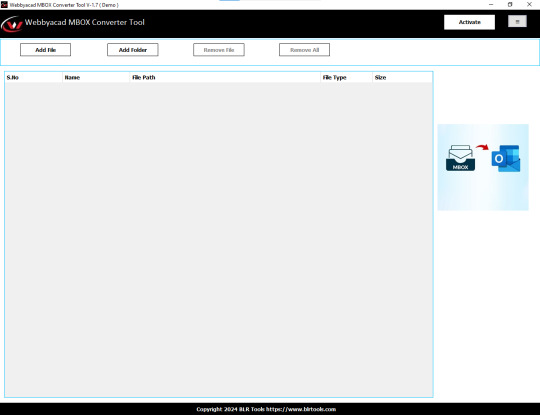
Step 2: Load the MBOX File
Launch the WebbyAcad tool and click on Add MBOX File.
Browse your computer to find the MBOX file you wish to convert and load it into the software.
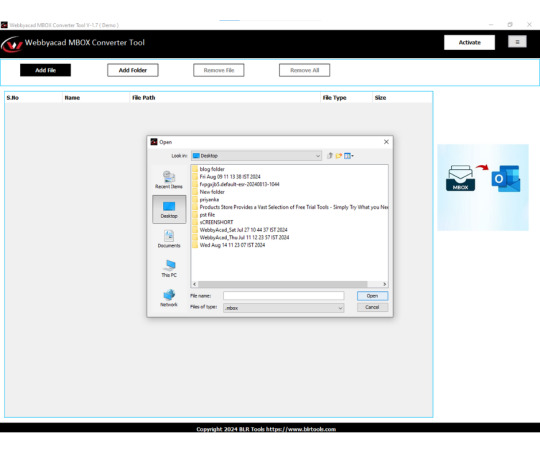

Step 3: Select PST as the Output Format
After the MBOX file is loaded, select PST as the desired output format. The WebbyAcad tool also allows you to convert MBOX files into other formats like EML, PDF, and more if needed.

Step 4: Convert the MBOX File to PST
Click on Convert, and the tool will begin converting your MBOX file into PST format. The process is quick, ensuring no data loss during conversion.
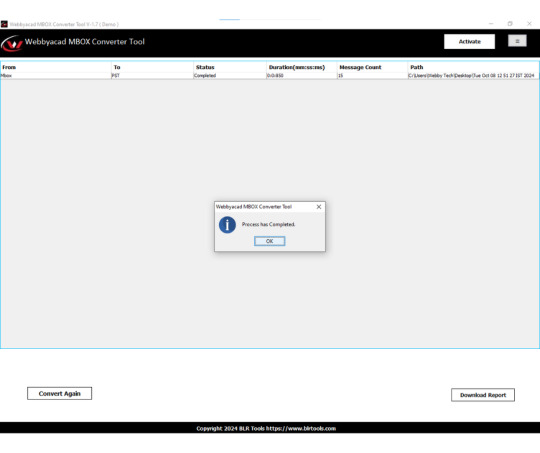
Step 5: Import the PST File into Outlook
Once the conversion is complete, open Microsoft Outlook and import the PST file by going to File > Open & Export > Import/Export. Follow the prompts to import the newly converted PST file into your Outlook account.
Benefits of Using WebbyAcad MBOX to PST Converter Tool
Data Integrity: Ensures that all your emails, including attachments and metadata, are accurately transferred.
Custom Output: Choose the output format that best suits your needs, such as PST for Outlook or other formats like EML or PDF.
Batch Processing: Convert multiple MBOX files at once, saving valuable time and effort.
Free Trial: WebbyAcad offers a free trial version, allowing you to test the tool’s functionality before making a purchase.
Fast and Efficient: The conversion process is rapid, ensuring minimal downtime during migration.
Conclusion
Converting MBOX files to PST is essential for users migrating to Microsoft Outlook from other email clients like Thunderbird or Apple Mail. While the manual method may work for some, it is time-consuming and prone to errors. For a more efficient, reliable, and user-friendly solution, the WebbyAcad MBOX to PST Converter Tool is the best choice. It simplifies the conversion process, ensures data accuracy, and supports batch processing for large-scale migrations.
#mboxconverter#mbox#mbox to pst#pst#converter tool#mboxconversion#free pst#outlook#apple mail#mail migration#migrate
0 notes
Text
Comprehensive Guide: Free Methods to Convert OLM File to Outlook PST
Migrating from Outlook for Mac to Outlook for Windows can be challenging, especially when it comes to converting OLM files to PST format. While there are various paid tools available to assist with this conversion, many users seek free methods to accomplish the task. In this comprehensive guide, we'll explore free methods to convert OLM files to Outlook PST, ensuring a smooth transition without the need for paid software.
What Are OLM and PST Files?
Before diving into the conversion process, it’s important to understand the difference between OLM and PST files:
OLM Files: OLM is the file format used by Outlook for Mac to store emails, contacts, calendars, tasks, and other mailbox items.
PST Files: PST (Personal Storage Table) is the file format used by Outlook for Windows to store similar mailbox data.
To access your OLM file data in Outlook for Windows, you must convert the OLM file to PST format.
Free Methods to Convert OLM to PST
Method 1: Using IMAP Configuration
One of the most effective free methods to convert OLM files to PST is by using an IMAP email account. This method involves syncing your OLM data to an IMAP account and then downloading it to Outlook for Windows. Here’s a step-by-step guide:
Step 1: Set Up an IMAP Account
Create a Gmail account (or use any other IMAP-supported email service).
Enable IMAP in the Gmail account settings:
Log in to your Gmail account.
Go to Settings > See all settings.
Click on the Forwarding and POP/IMAP tab.
Under the IMAP Access section, enable IMAP.
Step 2: Configure the IMAP Account in Outlook for Mac
Open Outlook for Mac.
Go to Tools > Accounts.
Click on the + icon to add a new account and choose Email.
Enter your Gmail account credentials and configure the IMAP settings:
Incoming server: imap.gmail.com
Outgoing server: smtp.gmail.com
Save the configuration and allow Outlook to sync with your Gmail account.
Step 3: Move OLM Data to the IMAP Mailbox
In Outlook for Mac, select the emails and other data you want to convert.
Drag and drop the selected items into the IMAP mailbox you configured earlier.
Allow the data to sync with your Gmail account.
Step 4: Configure the Same IMAP Account in Outlook for Windows
Open Outlook for Windows.
Go to File > Add Account.
Enter your Gmail account credentials and configure the IMAP settings.
Once configured, Outlook for Windows will begin syncing the data from your Gmail account.
Step 5: Export Data to PST
After the data syncs, go to File > Open & Export > Import/Export.
Choose Export to a file and select Outlook Data File (.pst).
Select the IMAP folder you want to export and complete the export process.
Method 2: Using Outlook for Mac and Exporting as a .txt or .eml File
Another free method involves manually exporting your OLM data into formats that can be imported into Outlook for Windows. This method is more labor-intensive and may not be suitable for large amounts of data but is still an option.
Step 1: Export OLM Data to .txt or .eml Format
Open Outlook for Mac.
Select the emails or data you wish to export.
Drag and drop the selected items to your desktop. This will save the items as .txt or .eml files.
Step 2: Import the Files into Outlook for Windows
Transfer the .txt or .eml files to your Windows PC.
Open Outlook for Windows.
Drag and drop the .txt or .eml files into the appropriate folders in Outlook.
Method 3: Using Apple Mail as an Intermediary
This method requires the use of Apple Mail to facilitate the conversion process. It’s another free option but requires both Outlook for Mac and Apple Mail installed on your system.
Step 1: Import OLM Data into Apple Mail
Open Outlook for Mac and export the mailbox to an OLM file.
Open Apple Mail and go to File > Import Mailboxes.
Select the OLM file to import the data into Apple Mail.
Step 2: Export from Apple Mail to MBOX Format
In Apple Mail, select the mailbox you imported.
Right-click on the mailbox and choose Export Mailbox.
Save the exported file in MBOX format.
Step 3: Convert MBOX to PST Using a Free Tool
Transfer the MBOX file to your Windows PC.
Use a free MBOX to PST converter tool available online to convert the MBOX file to PST format.
Import the PST file into Outlook for Windows.
Limitations of Free Methods
While these free methods can be effective, they have some limitations:
Time-Consuming: Manual methods can be labor-intensive, especially for large amounts of data.
Risk of Data Loss: There’s a higher risk of data loss or corruption during manual conversions.
No Direct Conversion: Most free methods do not offer a direct conversion from OLM to PST, requiring multiple steps and tools.
The Ultimate Solution: ATS OLM to PST Converter
For those looking for a more efficient and reliable method to convert OLM files to PST, the ATS OLM to PST Converter offers a powerful alternative. This tool simplifies the conversion process, ensuring that all your data is accurately and securely transferred from OLM to PST.
Key Features of ATS OLM to PST Converter:
Direct and Fast Conversion: Converts OLM files directly to PST format without any intermediary steps, saving time and reducing the risk of errors.
Multiple Output Formats: In addition to PST, the tool supports exporting to other formats such as EML, MSG, MBOX, PDF, and more.
Preserves Data Integrity: Maintains the original folder structure, metadata, and email properties, ensuring that all data remains intact.
User-Friendly Interface: Designed for ease of use, even for those without technical expertise.
Batch Conversion: Allows for the conversion of multiple OLM files at once, streamlining the process for users with large amounts of data.
Free Trial Version: Offers a free trial version, allowing users to convert a limited number of items to test the software before purchasing.
Why Choose ATS OLM to PST Converter?
While free methods are available, they often come with limitations that can make the process cumbersome and time-consuming. The ATS OLM to PST Converter eliminates these challenges by providing a straightforward, reliable, and efficient conversion process. Whether you’re dealing with large volumes of data or simply want a hassle-free experience, this tool is designed to meet your needs.
Conclusion
Converting OLM files to PST for Outlook 365 can be done using various free methods, though each has its own set of challenges. Whether you opt for IMAP configuration, manual export, or using Apple Mail as an intermediary, the methods outlined in this guide provide solutions without the need for paid software. However, for a more straightforward and risk-free conversion, the ATS OLM to PST Converter is an excellent choice, offering a powerful and user-friendly solution that ensures your data is accurately and securely migrated to Outlook for Windows.
Software available on Microsoft Store: https://apps.microsoft.com/detail/9nfvmwt3kjr6?hl=en-US&gl=US

#ATS OLM To PST Converter#OLM To PST Converter#Free OLM To PST#Migrate OLM To PST#OLM To IMAP Exporter#technology#news
0 notes
Text
Restore email mac mails with zero tolerance data integrity
Data integrity is often misjudged when it comes restore mac email. It is about overall accuracy, completeness and consistency of data. So whenever, data transfer takes place, the tool is expected to transfer or convert eh files with completeness and accuracy.
A non-accurate or incomplete transfer of data means the file is unreadable or unrecognizable or broken. In worst cases, the data files transfer or conversion does not take place.
This makes it very crucial to use a highly skilled restore mac email tool for an efficient transfer with zero tolerance data integrity.
We deliver a highly skilled and well-engineered product Mail Backup X. The one of its own kind to restore email mac mails. A tool that maintains hundred percent data integrity and also restore mac email addresses.
The factor is also visible in the applications of the restore mac email app delivering complete data file without any deviation.
Different particulars are transferred while taking backup of emails from Mac. Therefore. We also make sure that mac users undergo the information on Mac OS and Apple mail for a detailed tour on different aspects of them. So, it is advisable to browse the below links on Mac OS and Apple mail for more information.
Maintain data integrity factor in various applications that restore mac emails
It is indicative of the fact that different applications of this restore mac email software preserves data integrity while taking backup of emails from Mac.
The third party mail archive application supports reading and import of common mail archives file formats like .mbox, .rge, .olm, .olk, .pst, .eml, that store mail data by mail clients like Outlook Mac, Outlook Windows, Office 365, Thunderbird, Postbox, Gmail, Yahoo etc.
The inbuilt mail archive application allows you to view important mails from different mail clients. The product allows you to read and import archive files from Mbox viewer, RGE viewer, OLM viewer, OLK viewer, PST viewer, EML viewer without the need to switch between or open mails with different mail clients.
The third application of inbuilt mail migration application is an advanced mail conversion feature to use mail client of your choice on Mac OS. It permits you convert and export mail data to all major mail data file formats like .mbox, .rge, .olm, .pst, .eml.
Test the tool to explore the best way to restore mac email
The best way to explore the data integrity factor is by testing the tool for a realistic experience.

All you need is to download the demo version of the restore mac email tool and on Mac. Use it for 15 days until the validity expires.Switch to the licensed version of the tool, once satisfied.
For complete access of the product, you can click on the licensed version of the tool along with a product key.
For more details on the software, log on to the below website and get all your queries answered in a systematic manner www.mailbackupx.com/restore-mac-email/.
#mac restore tool#mac mail restore#restore mac mailbox#restore mac folder#restore mac data#restore mac files#restore mac email
1 note
·
View note
Text
What Is The Best Software To Convert OST to PST for MS Outlook?
The best software to convert OST to PST for MS Outlook often includes features like ease of use, reliability, and comprehensive support for various versions of Outlook. Among the top-rated options are Stellar Converter for OST,
which is known for its intuitive interface and robust performance, and Kernel for OST to PST Converter Tool, praised for its speed and accuracy in handling large files and complex conversions. Another highly recommended tool is SysTools OST to PST Converter,
which offers a straightforward conversion process and additional features like previewing emails before conversion and selective data export. These tools not only ensure a seamless conversion process but also offer additional functionalities to recover and manage your Outlook data efficiently.
How Can I Manually Convert An OST file To A PST file In MS Outlook?
Here are the steps to manually convert an OST file to a PST file in MS Outlook:
Open MS Outlook: Launch Microsoft Outlook on your computer.
Create a New PST File: Go to "File" > "Account Settings" > "Account Settings." In the "Data Files" tab, click "Add" and create a new Outlook Data File (.PST).
Export Data to PST: Go to "File" > "Open & Export" > "Import/Export."
Choose Export Option: Select "Export to a file" and click "Next."
Select PST Format: Choose "Outlook Data File (.PST)" and click "Next."
Choose OST Folder: Select the OST file's folder you want to convert (e.g., Inbox, Sent Items) and check "Include subfolders." Click "Next."
Select Destination: Browse to choose the location where you want to save the new PST file and name it. Click "Finish."
Set Password (Optional): You can set a password for the PST file, or leave it blank and click "OK."
Your OST file data will now be exported to the newly created PST file.
Are There Free Tools Available To Convert OST to PST for MS Outlook?
Yes, there are free tools available to convert OST to PST for MS Outlook, but they often come with limitations. Some popular free tools include OST2PST Kit and Free OST to PST Converter. These tools typically offer basic conversion capabilities but might have restrictions on the size of the files or the number of conversions.
For full features and better reliability, paid versions of these tools or more comprehensive software like Stellar Converter for OST or Kernel for OST to PST Converter are recommended. These paid tools provide more robust and efficient conversion options without limitations.
What Are The Steps To Convert An Ost File To A Pst File In MS Outlook?
Here are the steps to convert an OST file to a PST file in MS Outlook:
Open Outlook: Start Microsoft Outlook on your computer.
Go to Import/Export: Click on "File," then "Open & Export," and select "Import/Export."
Choose Export: Select "Export to a file" and click "Next."
Select PST Format: Choose "Outlook Data File (.PST)" and click "Next."
Select Folders: Pick the folders from the OST file you want to convert, check "Include subfolders," and click "Next."
Choose Save Location: Browse to select where you want to save the new PST file, name it, and click "Finish."
Set Password (Optional): You can set a password for the PST file or leave it blank and click "OK."
Your OST file data will now be converted and saved as a PST file.
Can I Convert An OST File To PST without Outlook Installed?
Yes, you can convert an OST file to PST without Outlook installed by using third-party conversion tools. These specialized software programs, such as Stellar Converter for OST or Kernel for OST to PST Converter, can directly convert OST files to PST format without needing Outlook on your computer.
They are designed to work independently of Outlook, making the conversion process simple and accessible even if you don’t have Outlook installed. This is especially useful if you need to access your emails and data from an OST file on a different system.
How Do I Recover Data From A Corrupt OST File And Convert It To PST?
Here are the steps to recover data from a corrupt OST file and convert it to PST:
Download Software: Download and install a specialized tool like Stellar Repair for Outlook or Kernel for OST to PST Converter.
Open the Tool: Launch the installed software on your computer.
Select OST File: Use the tool to browse and select the corrupt OST file you want to repair.
Scan the File: Start the scanning process to repair the corrupt OST file.
Preview Data: Once the scan is complete, preview the recoverable data displayed by the tool.
Save as PST: Choose the option to save the recovered data and select "PST" as the file format.
Save Location: Choose the location on your computer where you want to save the new PST file.
Finish: Complete the process by clicking "Save" or "Finish," and the tool will create the PST file with your recovered data.
What Is The Difference Between OST and PST files In Ms Outlook?
OST and PST files in MS Outlook serve different purposes. An OST (Offline Storage Table) file allows you to work offline by storing a copy of your mailbox on your computer, which syncs with the Exchange server when you're online again.
This is used with accounts like Exchange, Office 365, and Outlook.com. On the other hand, a PST (Personal Storage Table) file stores emails, contacts, and calendar data on your computer, and is commonly used for email backup or archiving, as well as with POP3 and IMAP accounts. Essentially, OST is for offline use with server synchronization, while PST is for personal data storage and backup.
How Can I Convert An Orphaned Ost File To A Pst File In Ms Outlook?
Converting an orphaned OST file to a PST file in MS Outlook involves these simple steps:
Open MS Outlook: Launch Microsoft Outlook on your computer.
Create a New PST File: Navigate to "File" > "Account Settings" > "Account Settings." In the "Data Files" tab, click "Add" and create a new Outlook Data File (.pst).
Import OST Data: Go to "File" > "Open & Export" > "Import/Export."
Select Import Option: Choose "Import from another program or file" and click "Next."
Choose File Type: Select "Outlook Data File (.pst)" and click "Next."
Browse for OST File: Click "Browse" to locate and select the orphaned OST file you want to convert.
Set Import Options: Choose how you want to handle duplicates and click "Next."
Select Destination: Choose the newly created PST file as the destination for importing the OST data.
Complete Import: Click "Finish" to start the import process.
Access Data: Once the import is complete, you can access the data from the orphaned OST file in the PST file within MS Outlook.
1 note
·
View note
Text
Simplifying Mac Outlook Migration: A Comparison of Free Methods and SysVita OLM Converter
Introduction
Migrating email data from Mac Outlook (OLM) to Windows Outlook (PST) can be a complex process. It's a transition often necessitated by a change in your operating system or collaboration requirements. In this article, we will explore both free methods and the third-party tool, SysVita OLM Converter, to understand how they simplify the Mac Outlook migration process.
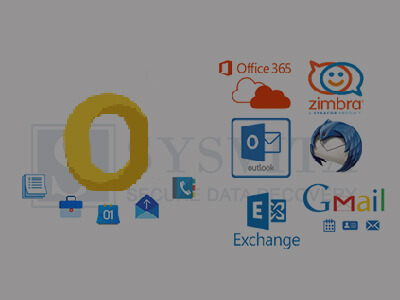
Free Methods for OLM to PST Conversion
Before delving into the benefits of SysVita OLM Converter, let's briefly review the limitations of free methods:
Manual Export and Import
Export from Mac Outlook: In Mac Outlook, navigate to "File" > "Export" > "Outlook for Mac Data File (.olm)" to create an OLM file containing your email data.
Transfer OLM to Windows: Move the OLM file to your Windows PC through email, a USB drive, or other means.
Import to Windows Outlook: In Windows Outlook, select "File" > "Open & Export" > "Import/Export." Choose "Import from another program or file," select "Outlook Data File (.pst)," and follow the on-screen instructions.
Pros:
Cost-effective, as it's free.
No third-party software required.
Cons:
Time-consuming and potentially error-prone.
Limited to email data only.
Risk of data loss during manual transfer.
IMAP Email Account Synchronization
IMAP synchronization is suitable for email items only, excluding contacts, calendars, and other data.
The setup process can be complicated, especially for users unfamiliar with IMAP configuration.
It may not preserve the folder structure and other essential data elements.
IMAP Email Account Synchronization
Setup IMAP Account: Configure IMAP email accounts on both Mac Outlook and Windows Outlook.
Synchronize Folders: Move emails from Mac Outlook folders to the IMAP account, allowing them to sync to the server.
Access on Windows: Configure the same IMAP account in Windows Outlook, and emails will sync down.
Pros:
Free and straightforward.
No third-party tool needed.
Cons:
Limited to email items.
IMAP setup can be complicated.
May not preserve folder structure and other data.
Third-Party Tool: SysVita OLM Converter-Simplifying Mac Outlook Migration
SysVita OLM Converter is a third-party tool designed to streamline and simplify the OLM to PST conversion process. Here are some key advantages:

Comprehensive Conversion
SysVita OLM to PST Converter can transfer not only emails but also contacts, calendars, tasks, and attachments, providing a complete migration solution.
Preservation of Folder Hierarchy
This tool maintains the original folder structure, ensuring that your data remains organized and accessible in Windows Outlook.
Efficiency and Reliability
OLM Converter automates the migration process, significantly reducing the risk of errors and data loss.
Users can rely on the tool's efficiency to complete large-scale migrations without the hassle of manual workarounds.
User-Friendly Interface
The software boasts an intuitive and user-friendly interface, making it accessible to users of all levels of technical expertise.
Data Integrity Guarantee
SysVita takes data integrity seriously, ensuring that your emails and other data elements are transferred without any compromise.
Technical Support
Users can benefit from SysVita's customer support in case of any migration issues or queries.
Positive User Feedback
SysVita OLM Converter has garnered positive reviews and recommendations from users, making it a trustworthy choice for OLM to PST conversion.
For Mac Pc: SysVita OLM Recovery Software
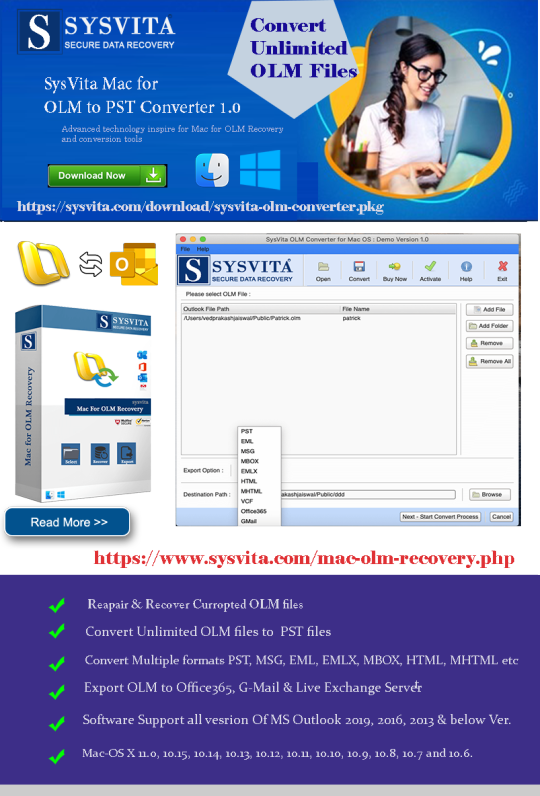
For Windows PC: SysVita OLM to PST Converter
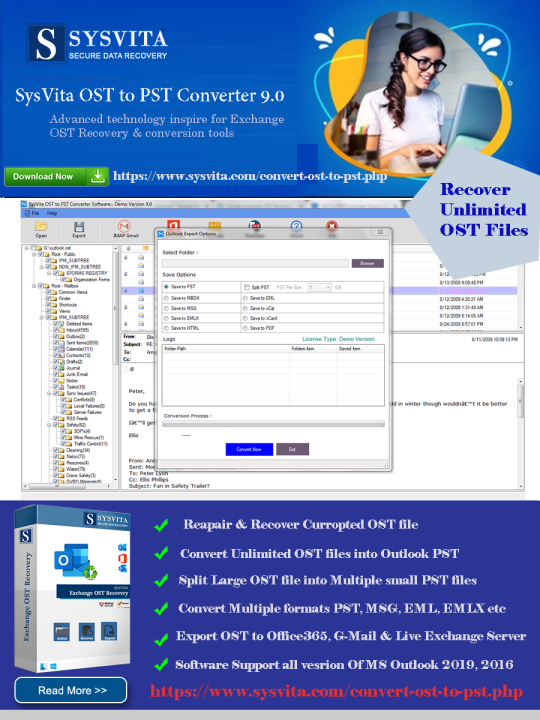
Conclusion
In the realm of Mac Outlook migration to Windows Outlook, free methods can be cumbersome, unreliable, and potentially risky in terms of data loss. SysVita OLM to PST Converter offers a dependable, efficient, and user-friendly alternative, simplifying the transition and ensuring that your valuable email data, including contacts, calendars, and more, is seamlessly migrated. When it comes to OLM to PST conversion, SysVita OLM Converter stands out as a robust solution that simplifies the process and guarantees data integrity.
Read more:
The Best 5 OLM Email Recovery Software for Mac – Get Your Lost Emails Back!
0 notes
Text
Best Proven Ways to Export Thunderbird to PST File Format
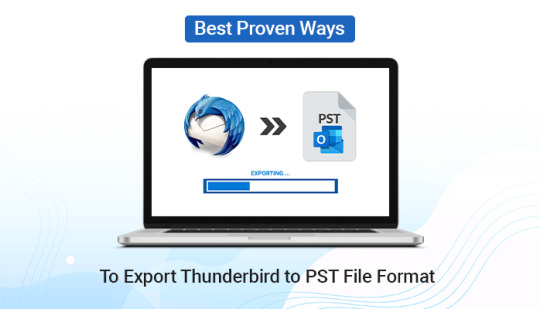
Summary: If you are looking for the best-proven ways to export Thunderbird to PST files then you are in the right place where we will explore the best and most secure solution for how to convert Thunderbird emails to Outlook PST by using the Manual method as well as Automated method. At the end of this article, we will provide the most professional Thunderbird Converter Tool which helps you to convert your Thunderbird files into Outlook PST without losing integrity.
Why We Need to Convert Thunderbird to PST File Format
Mozilla Thunderbird is our email client that works on Windows and Mac. There are so many reasons to Convert Thunderbird Emails to PST. In the below steps, we provide some reasons: - Outlook PST is the authorized application that includes so many advanced options which are not included in Mozilla Thunderbird. - Thunderbird does not have good quality customer support. - Mozilla Thunderbird despite being free of cost. - Because of the absence of features and security, this emails clients are losing their value with Outlook. Therefore, most of the users shifted to Outlook. We need to export Thunderbird emails to PST file formats.
Methods of How to Export Thunderbird Emails to PST
By using two methods you can export emails from Thunderbird to PST files without any hassle. In the below information, we will provide the best and most popular techniques that assist to export your Thunderbird emails to Outlook PST most effectively and simply. Method 1: Export Thunderbird to PST by Using Manual Method By using the manual method you can convert Thunderbird to PST file in the finest way. In the below steps, we mentioned the complete guideline to export Thunderbird emails to Outlook PST files. Steps to Convert Thunderbird Emails to PST by Using Manual Method - To begin, you have to go to the Thunderbird email clients and then open the folder you want to export your emails. - Then, choose a specific email, then tap and hold on Ctrl. - If you need to choose all emails you have to hold ctrl+A. - Then, use the right button of the cursor and click on the emails which you have selected - Click Save as an option to save at a suitable place. - After that open your Microsoft Outlook application. - Next, hit on the folder entitled Outlook and click the new folder. - Go to the next option section, mentioned the title name which you want to put n your new folder - Then Tap ok to generate it. - Choose all the emails that you saved from your Thunderbird by using the Ctrl+A button. - After choosing all your data, pull them into the new folder of the Microsoft Outlook application which you created in the previous steps. - In the final step post your imports after that, you easily view your all data. By following the above steps you can export Thunderbird to PST but there are so many disadvantages to using this method for exporting your files. Disadvantages of Using the Manual Method - To use the manual method the users need to know the technical knowledge because this method is quite technical and you can say typical way. - It takes too much time to convert Thunderbird to a PST file. In addition, it is too much lengthy process. - You are not able to convert Thunderbird emails to PST because they have to take individual emails in a single attempt during the time of conversion. - It does not convert multiple Thunderbird emails at one time. - There are so many chances of losing your data while converting files and so many security issues. Therefore, if you do not want to take the risk to lose your data then I would like to suggest you great and reliable method which is the Automated method. The users can convert their Thunderbird emails to PST when they do not know about technical knowledge. Method 2: Export Thunderbird to PST by Using an Automated Method The automated method is recommended by professionals. This method saves you time and there is no risk to lose your data. It also takes backup Thunderbird emails to an external hard drive. To use this technique you required the best software. I searched many websites. I found one of the most popular and amazing tools which is the Thunderbird Backup Tool. You can convert your files without any fear by using this tool. What Qualities Make Unique to this Software from Other Tools? - This software export Thunderbird to PST files as well as several file formats like MBOX, EML, PDF, CSV, HTML, TXT, JSON, and so on. with high accuracy. - It includes a awesome feature includes that assists users to migrate Thunderbird emails to multiple email clients for instance Gmail, IMAP, Hotmail, Office 365, AOL Mail and so many others. - Moreover, it offers users to preview all Thunderbird files and emails before taking action. - It converts Thunderbird to PST without attachment items and permits users to remove all duplicate emails at the time of the conversion process. - One more feature add that it maintains the folder hierarchy according to their original files. - It offers to users to make the source and destined the folder the same as the new folder. - Lastly, this software is supported with all Windows OS versions, for example, 10, 8, 7, etc. You can try the free demo version of this software where you can export 50 emails from Thunderbird to PST and other file formats like MBOX, EML, PDF, DOC, HTML, TXT, and so many others. Conclusion After all these methods we came to a solution if you have strong knowledge in the technical field then you can use the manual method otherwise I would like to advise users to use the automated method if they want to save time or they have bulk quantities of emails. Both methods are beneficial and best for you but it depends on you what you would like to choose for exporting Thunderbird to PST and various file formats as well as email clients without losing integrity. Read the full article
0 notes
Text
Zimbra to Outlook Converter
Zimbra Desktop is widely used by multiple users at it offers valuable and multiple services such as sending attachments, files, emails, manages tasks, and etc. There is no doubt that Zimbra is used by many people but most people prefer to opt for Outlook as their default email client application. Not many people are able to understand the complicated interface of Zimbra and that’s why the users prefer to export Zimbra to PST. In this blog, we will discuss the steps on how to move Zimbra files to Outlook.
Steps to Export Zimbra Files to Outlook Via the Manual Method
In this section, we have discussed the manual method, however, follow the below-mentioned steps carefully to avoid deletion of Zimbra mailbox items:
• Open Zimbra desktop and click on the ‘Preference’ option from the ‘Menu Tab’ • From the ‘Import and Export’ tab click on the ‘Advanced Settings’ option. • Now, determine the ‘Mail’ tab and uncheck the remaining option. • Click on the ‘Export’ tab. • Save the file in the desired file format. • Click on ‘OK’.
The above are the steps to export Zimbra files to Outlook using the manual approach. We recommend you avoid using this process as it can erase the entire data and cause data corruption. Make sure you pick the right and professional Zimbra Converter that ensures a 100 % positive result and performs a risk-free and secure conversion. The manual steps are complex and not all users can perform this tedious process as it involves a huge risk. If you have a large Zimbra mailbox, then you cannot opt for the manual method so we highly suggest you go for the right Zimbra Converter.
Reasons Why Does the User Export Zimbra Files to Outlook
● When the user wants to export their data to a particular format, then they move the TGZ files to Outlook. ● When the files exceed the file size limitation, then they prefer to opt for a Zimbra to PST converter to export Zimbra to Outlook. ● When the file becomes corrupt and damaged. ● Not all users are able to understand the complicated interface of Zimbra as not all users are from the Technical background.
Select Zimbra Converter to Export Zimbra Mailbox to Outlook
Zimbra to Outlook Converter is the ideal pick if you want to export Zimbra files to Outlook safely without corrupting the files. It exports TGZ files directly to Exchange Server and Office 365 accounts. The user can export all the email elements without changing the structure and Metadata. The advanced Zimbra to PST converter supports all the versions of Windows and Outlook. The software has an advanced feature, ‘Selective Zimbra Items’ that allows the user to select the file they want to move instead of selecting the entire data. Using the Zimbra Converter facilitates the users to export bulk Zimbra mailbox to PST by using the powerful option, that is the 'Batch Conversion’ feature.
Make certain that you opt for Zimbra to PST converter instead of using the manual approach to export Zimbra files to Outlook. It is a safer option that will give the flexibility to the users to perform a safe conversion of files.
Read More: https://www.kdetools.com/zimbra/
0 notes
Link
Hi Guys! Would you like to know how to open attachments in PST file without Outlook ? If so, this guide is for you.
The best solution for forensic investigators, home users, professionals, and other professionals to open PST attachments is the DotStella Outlook Forensics Wizard. It is a powerful and reliable software for easily opening and viewing PDF attachments. With the app, users don't need to install any external apps, including Outlook.
0 notes
Text
Split OST File
Learn how to split PST file. Know how to compact OST file. How to archive OST file. How to fix issues: Outlook PST File Too Large. Know how to Reduce Size PST File after Archiving & how to Compact PST File without Opening Outlook.

#OST File Too Large#Compact OST File#Archive OST File#Office 365 OST File Size Limit#Outlook PST File Too Large#Outlook PST File Size Limit#Reduce Size PST File after Archiving#Compact PST File without Opening Outlook
0 notes
Text
How can I save Outlook emails to my hard drive without using the PST file?
A common email system utilized by many industry experts or for personal work at a more basic level is Microsoft Outlook (MS Outlook). PST files, also known as Outlook data files, are used to store all of a user's mailbox information. However, users may wish to save Outlook emails on their hard drive rather than PST files in order to avoid PST file corruption, or they may wish to move emails from Outlook accounts to any other top-notch email client such as Thunderbird or Apple Mail. In this blog post, we will cover workaround ways for archiving Outlook emails that do not require PST files to be created. The instruction is compatible with all Outlook versions, including 2007, 2010, 2013, 2016, and 2019, and it allows you to backup Outlook emails to your computer.

Have you ever wondered why hard drives have become such a necessary piece of technology? In light of the fact that users have begun to consider the need of data backup, which includes archiving emails from an Outlook to a hard drive, this is an appropriate time for them to do so. Downloading important data onto an external hard drive is an excellent method of ensuring its safety. Before we get into the solutions, let's have a look at some of the possible reasons for backing up Outlook emails to a hard drive without a PST file.
{ "@context": "https://schema.org", "@type": "Organization", "url": "https://threejarsofbees.tumblr.com/", "mainEntityOfPage": "https://doamour.tumblr.com/" }
Exactly why do users want to archive Outlook email messages without using an Exchange server or a PST file?
We will discuss some of the most common reasons why a user would need to store Outlook emails on a new computer in the next section.
There is a potential that the system will crash or that some other tragedy will occur. Consequently, consumers prefer to save emails locally so that they may conveniently access the material later on in their lives.
It is necessary to backup emails when transitioning between systems, such as when switching from a desktop to a laptop.
It's possible that you'll want to transfer your data from one Outlook version to another.
Users who have been using Microsoft Outlook for more than just personal reasons may consider storing old emails and objects outside of the PST file format.
It's possible that the PST file is already existent on the system, and users do not want to add to the size of the system file.
So, these are the scenarios in which you may be required to archive emails without having a PST file on your PC.
The Best Way to Save Outlook Emails to Your Hard Drive Without Using a PST File
Making a backup copy of Outlook mailbox emails that does not contain the PST file helps to ensure that users do not lose their important data. Users may wish to archive their PST files in various saving formats in order to minimize harm or corruption of the PST file. It is simple to accomplish using the following methods:
Emails from Outlook Mailboxes should be saved in MSG format.
Save the contents of your Outlook Mailbox in CSV format.
Emails from your Outlook Mailbox should be saved in HTML format.
Emails from your Outlook Mailbox can be saved in PDF format.
Emails from the Outlook Mailbox should be saved to the hard drive as a Word document.
Let's go over each of these in greater detail:
Emails from Outlook Mailboxes can be saved in MSG format.
Downloading Outlook emails in MSG file format is a rapid and risk-free method of archiving them in a secure location. To do so, follow these steps:
In order to keep archived Outlook emails, first create a folder in the location of your choosing.
Afterwards, open Outlook and navigate to the email folder you want to read.
To select all of the emails, press the Ctrl + A key combination.
Additionally, drag and drop the folder into the newly formed folder for saving.
Following this, you will be prompted to save all of the emails you have selected in the MSG file format.
select the email message format (msg)
Save the contents of your Outlook Mailbox in CSV format.
Here's another method for archiving Outlook emails in CSV format without having to use the PST file format. The only condition is that you make use of the Outlook Import/Export capability. Follow the steps in the correct order:
Start Outlook and select File from the drop-down menu.
Select Open & Export from the drop-down menu, and then select Import/Export from the drop-down menu.
Select Open Export from the drop-down menu.
Select Export to a File from the Import and Export Wizard's drop-down menu and then click Next.
pick Export to a File from the drop-down menu
Next, select Comma Separated Value from the drop-down menu and press the Next button.
Choose Comma Separated Values (CSV).
Select the folder from which you want to export items, for example, Inbox. To proceed, click on the Next button.
choose a folder to save your work
Afterwards, click on the Browse button to select a location for the resulting file's destination. Select Next from the drop-down menu.
Then select the Export "Email messages" from folder: Inbox option from the drop-down menu.
Exporting Email Messages should be checked.
To bring the procedure to a close, click on the Finish button.
Finish by clicking on the button.
Finally, all of the emails in your Outlook mailbox will be saved to a CSV file on your computer's hard disk.
Emails from your Outlook Mailbox can be saved in HTML format.
You will be able to store emails from Outlook in HTML format in addition to MSG and CSV formats. The following are the procedures to be followed:
To begin, open Outlook and choose the email from which you want to save it by double-clicking on it.
It will launch a fresh email wizard in a new window. Select the Save As option from the File menu by clicking on the File button.
Assign a name to the folder and select HTML as the saving format from the drop-down menu in the opening window.
Following that, click on the Save option to get it downloaded in HTML format.
If you have any more emails that you want to archive, you can follow the same steps as above.
Emails from your Outlook Mailbox can be saved in PDF format.
First and foremost, in order to save Outlook emails in PDF format, you must first download them as HTML by following the instructions above. Then follow the instructions outlined below:
Open the HTML-based email in any web browser, such as Google Chrome, to view it.
Then use the Ctrl+P keyboard shortcut and select the Save as PDF option from the drop-down menu.
Click Save and navigate to the folder where you want to save it after that.
Finally, click on the Save option to bring the working process to a close.
Emails from the Outlook Mailbox should be saved to the hard drive as a Word document.
In order to back up Outlook mailbox emails in Word format, you must first save the email as HTML by following the instructions outlined in the previous section. After that, follow the instructions outlined below:
In this case, you must open Word and select the File>>Open option.
Now, locate the HTML-based email file that was previously saved and open it in Microsoft Word.
Then, to save the file as a Word document, select File>> Save As from the menu bar.
If none of the ways listed above work for you, you can try the following: save Outlook emails to hard disk without using PST. A recommendation will be made for you to back up your Outlook emails to your computer in the PST file format and then convert them into one of the 15+ file formats supported by SysInfo PST File Converter. MSG, EML, MBOX, CSV, OST, HTML, DOC, PNG, JSON, TIFF, and other formats are available for saving. In addition, you can import PST files into Office 365, Gmail, Thunderbird, AOL, IMAP, Live Exchange, Hotmail, and other email clients, such as Outlook and Thunderbird.
Conclusion
It has been addressed in this blog post about How to Save Outlook Emails to the Local Hard Drive Without Using a PST file, as well as the reasons and instances in which it is important to backup an email from an Outlook mailbox.
4 notes
·
View notes
Text
How Can I Export PST File From Mbox?
When it comes to migrating emails between different platforms or email clients, one of the most common requirements is converting MBOX files to PST format. MBOX is widely used by email clients such as Thunderbird, Apple Mail, and Gmail for storing email data, while PST is the preferred format for Microsoft Outlook. If you’re transitioning to Outlook from another email platform, exporting your data from MBOX to PST is essential.
In this blog, we’ll walk you through the process of exporting PST files from MBOX files, and explain how WebbyAcad MBOX to PST Converter Tool makes the task simple and efficient.
Why Convert MBOX to PST?
Before we dive into the steps, it’s important to understand why converting MBOX to PST is necessary:
Compatibility: MBOX is not natively supported by Microsoft Outlook, which relies on PST for managing and storing emails. If you’re switching to Outlook, converting your MBOX files ensures that your data is fully accessible.
Migration Between Platforms: If you're moving from email clients like Thunderbird, Apple Mail, or Eudora to Outlook, converting your MBOX files to PST will make the transition smooth.
Data Security and Management: PST files are designed for seamless integration with Outlook’s features, ensuring better data management, enhanced security, and greater accessibility across multiple Outlook-supported platforms.
Methods for Exporting PST from MBOX
There are two primary ways to export PST files from MBOX: the manual method, which involves multiple steps and different email clients, and the professional method using WebbyAcad’s MBOX to PST Converter tool. Let’s explore both methods.
Manual Method for MBOX to PST Conversion
The manual method requires the use of both Mozilla Thunderbird (which supports MBOX files) and Microsoft Outlook (which supports PST files). Below are the key steps involved in manually converting MBOX to PST.
Step 1: Install Mozilla Thunderbird
Download and install Mozilla Thunderbird on your computer. Thunderbird is a free, open-source email client that supports MBOX files.
Step 2: Import MBOX File into Thunderbird
Import your MBOX file into Thunderbird. You can do this using the ImportExportTools NG add-on in Thunderbird:
Go to Tools > Add-ons > Search for "ImportExportTools NG" and install it.
Restart Thunderbird and then go to Tools > ImportExportTools > Import MBOX file.
Locate your MBOX file and import it into Thunderbird.
Step 3: Transfer Emails to Outlook
Open both Thunderbird and Microsoft Outlook.
Drag and drop emails from Thunderbird to Outlook. Unfortunately, this process can be tedious, especially if you have a large volume of emails or multiple MBOX files to convert.
Step 4: Save Emails as PST
Once your emails are in Outlook, they will automatically be stored in the PST format. You can back up your PST file for future use by navigating to File > Open & Export > Import/Export, and choosing to export your Outlook data to a PST file.
Drawbacks of the Manual Method
While the manual method is possible, it’s highly time-consuming and requires careful handling to avoid data loss. It also involves multiple steps and tools, which may not be ideal for users with limited technical expertise or those dealing with large data volumes. Additionally, attachments, metadata, and folder structures might not be properly preserved.
Professional Method: Using WebbyAcad MBOX to PST Converter Tool
For a seamless and reliable solution, the WebbyAcad MBOX to PST Converter Tool is the most effective way to export PST files from MBOX. Here’s why using a professional tool is the preferred option:
Simplicity: WebbyAcad’s user-friendly interface makes it incredibly easy to convert MBOX files to PST without any technical expertise.
Accuracy: The tool ensures complete data integrity during the conversion process, meaning no loss of emails, attachments, or metadata.
Batch Conversion: Save time by converting multiple MBOX files into PST format at once, making it ideal for large-scale email migrations.
Speed: Compared to the manual method, WebbyAcad offers fast and efficient conversion, significantly reducing the time it takes to complete the task.
Compatibility: The tool supports a wide range of MBOX-based email clients like Thunderbird, Apple Mail, Gmail, and more, making it a versatile solution for users.
Here’s how you can use WebbyAcad MBOX to PST Converter Tool to export PST from MBOX files:
Step 1: Download and Install WebbyAcad MBOX to PST Converter Tool
Visit the official WebbyAcad website, download the MBOX to PST Converter Tool, and install it on your computer.
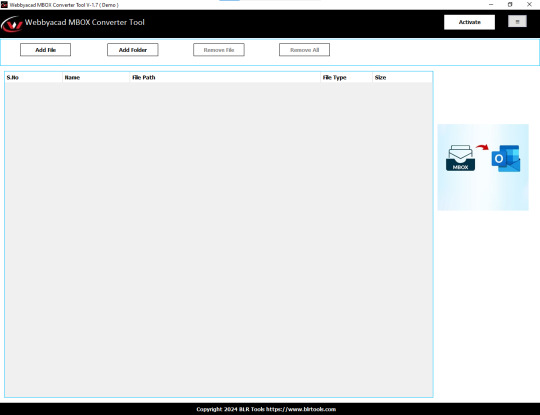
Step 2: Load the MBOX File
Launch the WebbyAcad tool and click on Add MBOX File.
Browse your computer to find the MBOX file you wish to convert and load it into the software.


Step 3: Select PST as the Output Format
After the MBOX file is loaded, select PST as the desired output format. The WebbyAcad tool also allows you to convert MBOX files into other formats like EML, PDF, and more if needed.

Step 4: Convert the MBOX File to PST
Click on Convert, and the tool will begin converting your MBOX file into PST format. The process is quick, ensuring no data loss during conversion.

Benefits of Using WebbyAcad MBOX to PST Converter Tool
Data Integrity: Ensures that all your emails, including attachments and metadata, are accurately transferred.
Custom Output: Choose the output format that best suits your needs, such as PST for Outlook or other formats like EML or PDF.
Batch Processing: Convert multiple MBOX files at once, saving valuable time and effort.
Free Trial: WebbyAcad offers a free trial version, allowing you to test the tool’s functionality before making a purchase.
Fast and Efficient: The conversion process is rapid, ensuring minimal downtime during migration.
Conclusion
Converting MBOX files to PST is essential for users migrating to Microsoft Outlook from other email clients like Thunderbird or Apple Mail. While the manual method may work for some, it is time-consuming and prone to errors. For a more efficient, reliable, and user-friendly solution, the WebbyAcad MBOX to PST Converter Tool is the best choice. It simplifies the conversion process, ensures data accuracy, and supports batch processing for large-scale migrations.
0 notes